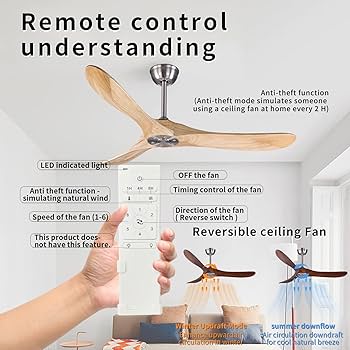Ceiling fans create airflow by spinning the blades, generating low pressure below them, drawing up room air, and pushing it outward. They do not lower room temperature but create a cooling effect by circulating air, improving comfort year-round.
Ceiling fans use electricity to power the motor that rotates the blades, allowing them to cool the room. Unlike air conditioners, ceiling fans focus on cooling people rather than the space itself. Understanding the mechanics behind how ceiling fans work can help maximize their efficiency and benefits in maintaining a comfortable living environment.
By harnessing the principles of airflow circulation, ceiling fans play a significant role in creating a pleasant indoor atmosphere and enhancing air movement within a room.

Mechanics Of A Ceiling Fan
Ceiling fans create airflow by spinning the blades in a circular motion. This motion generates a low-pressure area beneath the blades, drawing air up from the room. The air is then pushed outwards towards the edges of the blades, creating a breeze that helps cool the room.
The electrical working of a ceiling fan involves…
- Using a single-phase induction motor to drive the fan blades.
- Connection to a power source through a switch for on/off control.
- Including capacitors to adjust the speed of the motor.
Additionally, ceiling fans do not lower the room temperature but provide a wind chill effect for cooling.

Credit: www.amazon.com
Impact On Room Temperature
Ceiling fans create a “wind chill effect” that makes you feel cooler by circulating the air in a room, but they don’t actually lower the temperature. They are designed to cool people, not rooms, and can improve comfort year-round.
Cooling Effect Of Ceiling Fans
Ceiling fans create a wind-chill effect that makes you feel cooler. They circulate air to create a draft throughout the room. Ceiling fans effectively improve comfort year-round.Electricity Consumption Of Ceiling Fans
Ceiling fans are energy-efficient, consuming minimal electricity. Compared to air conditioners, ceiling fans use significantly less power. Operating a ceiling fan costs only a few cents per hour. Ceiling fans help save energy and lower utility bills.Using Ceiling Fans Effectively
How does a ceiling fan work to cool? Ceiling fans are considered the most effective of these types of fans, because they effectively circulate the air in a room to create a draft throughout the room. Ceiling fans can help improve comfort year round. In the summer, operate the ceiling fan in a counterclockwise direction. Unlike air conditioners, ceiling fans don’t actually lower the temperature in a room. Instead, they offer a “wind chill effect” that helps you feel cool from the breeze brushing against your skin. Keep in mind that ceiling fans are designed to cool people, not rooms. When the fan is turned on, the blades start to spin in a circular motion. As they move, they create a low-pressure area beneath them, which causes air to be drawn up from the room. This air then moves towards the blades and is pushed outwards towards the edges of the blades. Ceiling fans are known for using less electricity than air conditioners and can be a cost-effective way to cool a room.
Optimizing Ceiling Fans In Summer And Winter
To optimize ceiling fans in summer, operate the fan in a counterclockwise direction to create a breeze, providing a cooling effect through the “wind chill” sensation. This can allow you to raise the thermostat setting and save on cooling costs. In winter, reverse the fan’s direction to a clockwise rotation at a low speed to circulate warm air trapped at the ceiling, helping to distribute heat more evenly throughout the room. This can help reduce heating costs and increase comfort during colder months.

Credit: www.walmart.com

Credit: nemmadi.in
Frequently Asked Questions For How Ceiling Fans Work
How Does A Ceiling Fan Work To Cool?
Ceiling fans work by circulating air in a room to create a draft, improving comfort year-round. In the summer, operating the fan in a counterclockwise direction creates a wind chill effect that helps you feel cooler. However, ceiling fans do not actually lower the temperature of a room.
They are designed to cool people, not rooms.
Do Ceiling Fans Actually Lower The Temperature Of A Room?
Ceiling fans do not lower the room temperature. They create a “wind-chill effect” by circulating air, making you feel cooler. Keep in mind that ceiling fans are designed to cool people, not rooms.
How Does Ceiling Fan Airflow Work?
Ceiling fans create airflow by spinning the blades, creating a low-pressure area that draws air up from the room. The moving air then circulates throughout the room, providing a cooling effect by pushing air towards the edges of the blades.
Do Ceiling Fans Use A Lot Of Electricity?
Ceiling fans are energy efficient, using around 15-90 watts, depending on speed. They are cost-effective for cooling.
How Do Ceiling Fans Cool A Room?
Ceiling fans create a wind chill effect by circulating the air in the room, making you feel cooler.
Conclusion
Ceiling fans work by creating airflow that helps cool down a room. The rotation of the blades creates a breeze that makes you feel cooler, much like a wind chill effect. Contrary to air conditioners, ceiling fans do not actually lower the temperature, but they effectively circulate air to enhance comfort.
Understanding how these fans function is essential in maximizing their benefits year-round.